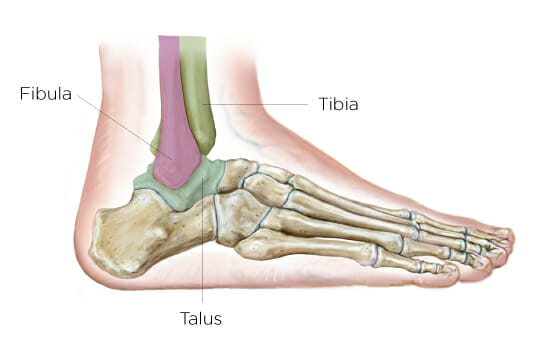Ankle surgery is a treatment for ankle injuries, such as fractures and severe sprains. Your ankle has many parts, including bones, cartilage, ligaments and joints, and they all work together to enable smooth movement and flexibility. This intricate system supports essential activities such as walking, running and jumping.
Over time, normal wear and tear from aging can lead to joint damage. Injuries may also happen because of trauma or while playing sports. A strain, sprain, fracture, damage to soft tissues or a torn ligament can affect any part of the ankle.
When rest, physical therapy or medication don’t work, board-certified and fellowship-trained orthopedic surgeons at Summit Orthopedics in the Minneapolis/St. Paul area offer ankle surgery to help fix damage, lessen pain and help restore function.

Benefits of Ankle Surgery
Ankle surgery can provide significant relief and improve your quality of life, especially when other treatments haven’t worked. Some of the main benefits include:
- Improved mobility and stability: Ankle surgery can restore proper alignment and function in the ankle, allowing for smoother movement.
- Reduced pain, swelling and stiffness: Surgery addresses the root cause of discomfort, helping you feel better and move more easily.
- Return to the activities you love: Whether you’re walking, exercising or enjoying your favorite sports, surgery can help you get back to doing what you enjoy.
Types of Ankle Surgery
Arthroscopy and Minimally Invasive Surgery
We use minimally invasive surgery techniques, such as ankle arthroscopy, for many foot and ankle conditions. Through small cuts in the skin, your surgeon inserts a tiny camera and instruments to examine and treat the ankle joint. This method is ideal for cleaning up loose pieces of cartilage, repairing minor damage and preserving ankle motion.
Ankle Ligament Reconstruction
If you have repeated ankle sprains or chronic instability, surgery may be necessary. During ankle ligament reconstruction, your surgeon repairs or replaces damaged ligaments to restore stability. The goal is to prevent future sprains and help your ankle function normally again.
Ankle Fusion Surgery
For severe arthritis or major joint damage, ankle fusion surgery is often effective. During this procedure, your surgeon removes damaged cartilage and bone surfaces and uses metal plates and screws to hold the bone growths together. While you lose some ankle motion, most people find relief from pain after surgery.
Total Ankle Replacement
In total ankle replacement, your surgeon takes out damaged joint surfaces and replaces them with an artificial joint made of metal and plastic. This joint replacement procedure aims to restore ankle motion while relieving arthritis pain.
Reasons for Ankle Surgery
Surgery may be needed if injuries don’t improve with rest, physical therapy or bracing. In some cases, surgery offers the best chance for long-term recovery and a return to normal activities.
Common reasons for ankle surgery include:
- Ankle fractures: When one or more bones are broken or out of place, causing joint instability
- Arthritis: To relieve chronic pain, stiffness and loss of motion
- Severe ankle sprains: When ligaments are torn or stretched beyond healing
- Osteochondral lesions: Injuries to cartilage and bone in the ankle joint
What to Expect
Whenever possible, we offer surgeries as outpatient procedures, which means you can go home the same day. Our goal is to minimize trauma and speed up healing. With smaller incisions and precise techniques, we often reduce pain and swelling and offer a quicker recovery.
Recovery After Ankle Surgery
Once treatment is complete, physical therapy can play a vital role in restoring strength, flexibility and function. In the early part of your recovery, you may wear a boot or splint to support your lower leg to ensure your ankle heals correctly.
- After arthroscopy, you can bear weight as tolerated and often require minimal immobilization.
- After ligament surgery, fusion or replacement, you may need to avoid putting weight on your ankle for several weeks. Then, you can gradually return to full activity.
- Physical therapy is personalized based on your procedure and progress, helping to restore full function.
Ankle Surgery at Summit Orthopedics
At Summit Orthopedics, we take a thoughtful and personalized approach to ankle care. Whenever possible, we start with nonsurgical treatments and focus on the least invasive options that offer relief and restore function.
If surgery is necessary, we use a collaborative team approach. Our experts in orthopedic surgery, physical therapy and sports medicine work together to deliver the highest level of care.
Summit Orthopedics surgeons are available at nearly 30 convenient locations across the Minneapolis/St. Paul metro area, serving Minnesota and western Wisconsin. Our state-of-the-art, comprehensive orthopedic centers offer same-day appointments from a team of experts who offer the full scope of orthopedic care.
Find your Summit Orthopedics ankle surgery expert, request an appointment or call us at (651) 968-5201 to schedule a consultation.
